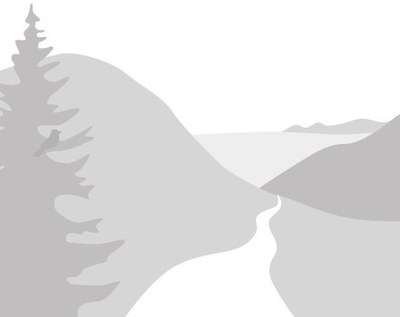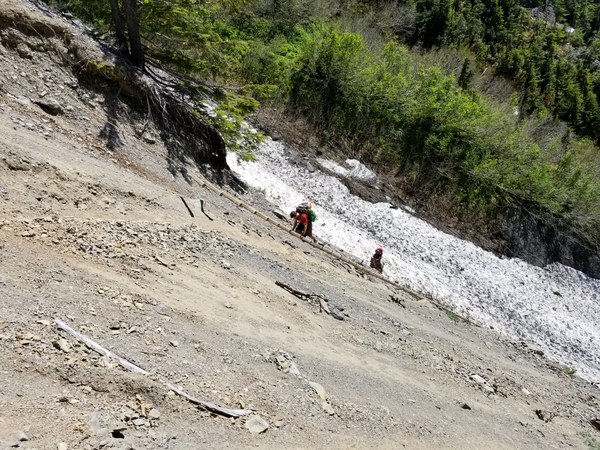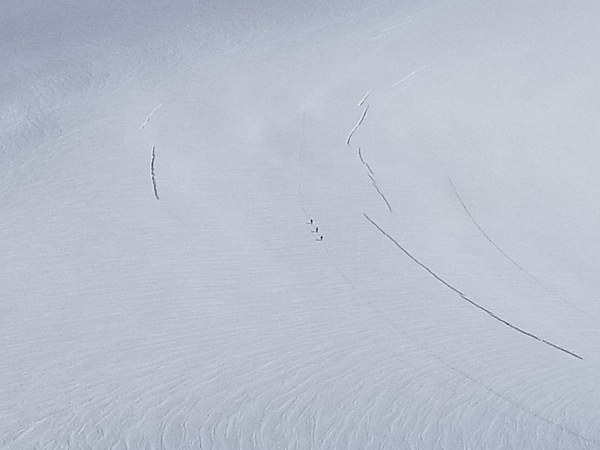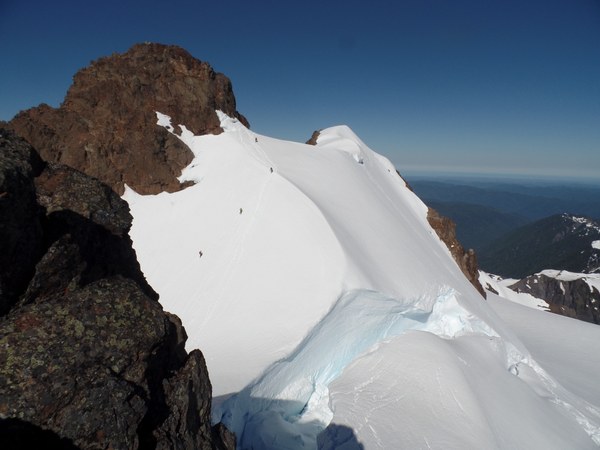
Trip Report
Basic Alpine Climb - Mount Olympus/Blue Glacier
Relaxing 4 day climb with a successful summit
- Thu, Jun 22, 2017 — Sun, Jun 25, 2017
- Basic Alpine Climb - Mount Olympus/Blue Glacier
- Mount Olympus/Blue Glacier
- Climbing
- Successful
-

- Road suitable for all vehicles
-
Trail from Hoh TH to Elk Lake was free of snow and mostly dry, muddy in a few spots. Some snow past Elk Lake but melting out fast. The ladder .25 miles before Glacier Meadows is still there, however, erosion and wiped out most of the earth on the upper part of the ladder, suspending it 4-5 feet off the ground. It’s recommended that you climb next to the ladder, using it as a handhold. Glacier Meadows is still 75% snow covered but melting out rapidly

Approach to the lateral moraine is 95% snow covered. I would advise keeping climbers left and following the snow gully to the end of the lateral moraine, where you can follow the climbers path down to the Blue Glacier.
Blue Glacier is covered in snow; crevasses are starting to open up, but the 2 or 3 we saw are 3” wide at max. The snow up to Snow Dome was good except for some post holing near the rock bands. The traverse from Snow Dome to Crystal Pass has obvious crevasses which are easy to navigate around. The bergschrund is open so direct routes to the summit are inaccessible.

There are a couple of crevasses opening up between Crystal Pass and the false summit. We were able to step over them (maybe 6” wide).
A snow ramp exists up to the middle anchor of the summit block. Easy 5.4 rock climb up to the top anchor, which puts you a 4th class move and some easy 3rd class scrambling up to the summit. We rappelled down on a 50 m rope with about 6 meters to spare. Recommend bringing a longer rope later in the season.
A gorgeous, uncomfortably warm, 4 day climb of the West Peak of Mt Olympus began on Thursday. Our team met up at the Hoh River Trailhead at 2pm. After some discussion and gear checks, we started down the trail at 330. Our first camp was at Lewis Meadows, which we reached around 730, where we camped on the beach and had a campfire. I would watch out for sand fleas, as I was bitten numerous times (upwards of 50).
Day 2 consisted of the hike from Lewis Meadows to Glacier Meadows. We stashed extra food and gear at Elk Lake before pushing on. Note that snow is patchy about a mile past Elk Lake. Temperatures were quite warm, hovering in the high 70’s, so we stopped frequently for breaks and water. The ladder .25 miles before Glacier Meadows is still present and in good condition, however, the ground beneath the upper portion of the ladder has eroded away, suspending it 4-5 feet off the ground. I’d recommend downclimbing next to the ladder and using it as a hand hold. Glacier Meadows is still mostly snow covered, but there are portions have melted out and a dry enough to camp on. Mosquitoes were pretty fierce.
Summit day began with a 3 am start up the gully to the terminal moraine. As we found out later, there is snow all the way to the end of the moraine, so do not head up to the ridge too early or else you will be doing some fairly exposed scrambling. The descent onto the Blue Glacier was loose, but not the loosest mess we’ve seen. The Blue Glacier is still completely snow covered, with small 4” crevasses just beginning to open up. While roping up, a solo climber sped past us in train runners as he made his way to the West Peak. We placed 3 climbers on a 30 m rope and 4 climbers on a 50 m rope. We took approximately 25 minutes to cross the Blue. From there, we short roped and ascended to the top of snow dome, which took us approximately an hour and a half; we topped out at 7 am. From there we crossed Snow Dome and made the rising traverse to Crystal Pass. The crevasses below our traverse were opening up, some no more than 6” wide, others 20 feet wide. We could see that the bergschrund had opened up, preventing direct access to West Peak. We reached Crystal Pass and rested in the shade while 2 teams of 2 went by us.

The ascent up to the false summit was easy to navigate but tortuously hot; we took a direct path and stepped over two crevasses no more than 6” wide, but the morning heat (around 930 by this point) had already reach what felt like 80 – 90 degrees. We elected to follow a snow ramp directly up the false summit. We took another break as we watched the solo climber downclimb the West Peak and the team of 4 rope up for the climb. We finally made it over to the summit block around 1045 and every summited by 1145. We brought a small rack with us and some tricams, but the tricams were not needed. I believe a number 1 and a number 2 were placed.We stayed up on the summit for about 60 minutes waiting for the team of 4 to rappel and a team of 3 to ascend. We were all off the summit block by 145. The 50 meter rope was more than sufficient to get us back down to the snow.
The descent back down to the Blue Glacier took about an hour and we were back on the lateral moraine by 330, back at our tents by 415. We traded gear, packed all of our tents, and headed down to Elk lake and were in camp by 7. Unfortunately, another group of campers had taken over the group site (it wasn’t marked and the campers were no where to be seen) so we crowded 4 tents in one site and 2 in another.
Day 4 consisted of the hike out. Temperatures were in the low to mid 80’s and was stifling. We needed to take many more breaks in order to avoid heat exhaustion. We also had an interesting encounter with a young bear dropping out of a tree 30 feet from us and hanging out. All climbers were back at their cars by 4pm.
 Peter Tran
Peter Tran